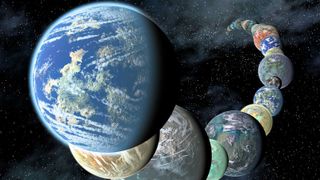Astronomers can't wait to search for signs of life and massive black-hole mergers
From black holes to the search for life, scientific breakthroughs are on the horizon.

The James Webb Space Telescope (JWST or Webb) might get all the credit, but a whole new era of telescopes — in space and on the ground — is set to revolutionize astronomy in the next two decades.
From black holes to the search for life and beyond, all of astronomy's greatest mysteries are on the table — and astronomers are already planning how to solve them, using tools that range from the biggest space telescopes to arrays of tiny radio telescopes scattered across a desert on Earth. Even if some ideas feel far-fetched, astronomers are hard at work brainstorming how best to bring these projects to fruition, and how they will complement today's cutting-edge instruments, as scientists explained at the 241st meeting of the American Astronomical Society held in Seattle and online earlier this month.
"JWST is great, but it is not enough," Jane Rigby, an astronomer at NASA's Goddard Space Flight Center in Maryland who has led scientists through the observatory's first year, said at the conference. To truly make progress, she added, will require "using all the tools in our astronomical toolkit and future tools to be planned and built."
Related: The 10 biggest telescopes on Earth
Biology on alien planets
Starting from the smaller scale, future astronomical facilities will finally — hopefully — bring about the first detection of life on another planet in the coming years. Exoplanet astronomers are searching for planets around other stars that host conditions in which life can likely thrive, and simultaneously figuring out how to "recognize whether an extrasolar planet can or does support life," Victoria Meadows, an astrobiologist at the University of Washington, said at the conference.
Recognizing life and understanding a planet's conditions are really complicated tasks, though. Not only do we need to look for the actual signs of life, known as biosignatures, but we also need to understand the context in which we spot those signs — the planet's environment, even including the behavior of the star it orbits. Excitingly, "JWST and ground-based telescopes will be able to start the search for life, like, right now," Meadows said.
Looking ahead, the major Habitable Worlds Observatory (HWO), planned for the 2030s, will be able to peer deeper into these planets' atmospheres and give us an even better shot of finding life. Whereas JWST mainly uses transits — a planet crossing in front of its star — to observe Earth-size exoplanets, the Habitable Worlds Observatory will take a more direct approach, imaging the planets themselves, even down to Earth-like sizes.
Get the Space.com Newsletter
Breaking space news, the latest updates on rocket launches, skywatching events and more!
Behemoth observatories here on Earth also promise new insights into the search for life. A new class of observatories known as "Extremely Large Telescopes" or ELTs are under construction in Hawaii and Chile. These mammoth projects will have mirrors around 98 feet (30 meters) in diameter, which is two times as tall as the Hollywood sign and almost three times larger than any other optical telescope in existence.
Although JWST, the HWO and other space-based observatories are powerful tools, they come with hefty price tags, so astronomers will rely on complementary ground-based telescopes like they always have — however, now those ground-based telescopes will be much more powerful.
The biggest black holes
The coming decades also promise new ways of seeing — or rather, hearing — the universe, including the ability to detect more types of gravitational waves, or ripples in the fabric of space-time. "LIGO [the Laser Interferometer Gravitational Wave Observatory] is currently the only gravitational wave detector to have made a direct observation of gravitational waves and that's amazing," Chiara Mingarelli, an astronomer at the Flatiron Institute in New York, said during the conference. However, LIGO is only looking at a small fraction of the whole spectrum of gravitational waves — there are plenty of signals it's not able to observe.
For these other gravitational waves, distinguished by their lower frequencies and longer-lasting signals, astronomers will need to wait for the space-based detector known as LISA, the Laser Interferometer Space Antenna. Like a massive LIGO detector, LISA will keep three satellites in a huge and perfect triangle as they all orbit the Earth together. "LISA sources will be baby supermassive black holes," Mingarelli explained, in contrast to the smaller mergers LIGO has seen.
To find the gravitational wave signatures of the biggest behemoths and other quirky additions to the universe's soundscape that are beyond even the reach of LISA, astronomers will need another technique known as pulsar timing. Pulsars are spinning dead cores of large stars that each shoot two beams of light into space like a cosmic lighthouse. Pulsars are often used to time events in the cosmos because they're so predictable that their time-keeping would only be off by 100 nanoseconds over an entire decade.
As gravitational waves pass through pulsars, astronomers can spot the tiny changes in the pulsar's regular rhythm. This method promises to reveal colliding pairs of black holes in which each partner is around a billion times the mass of our sun; the technique can also begin watching a black hole tango up to 25 million years before the objects merge.
Tens of radio telescopes across the globe, from the Deep Synoptic Array in California to the MeerKAT telescope in South Africa and beyond, are undergoing upgrades and working together to gather the data needed for pulsar timing to reveal the impact of gravitational waves from supermassive black holes.
These projects are only a fraction of the ideas astronomers have for the future of space exploration. But whatever the technology, from ELTs to mega-sized space telescopes and beyond, scientists hope they will help answer our most fundamental questions: where did we come from, and are we alone? It's a historic time for astronomy, and for humankind as a whole.
Follow the author at @briles_34 on Twitter. Follow us on Twitter @Spacedotcom and on Facebook.
Join our Space Forums to keep talking space on the latest missions, night sky and more! And if you have a news tip, correction or comment, let us know at: community@space.com.

Briley Lewis (she/her) is a freelance science writer and Ph.D. Candidate/NSF Fellow at the University of California, Los Angeles studying Astronomy & Astrophysics. Follow her on Twitter @briles_34 or visit her website www.briley-lewis.com.
